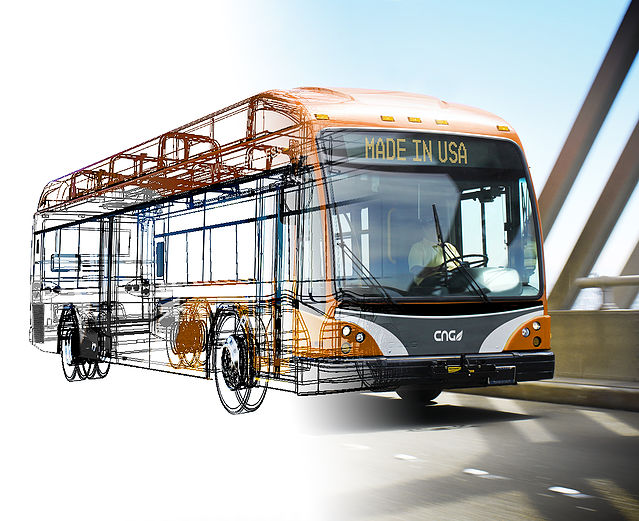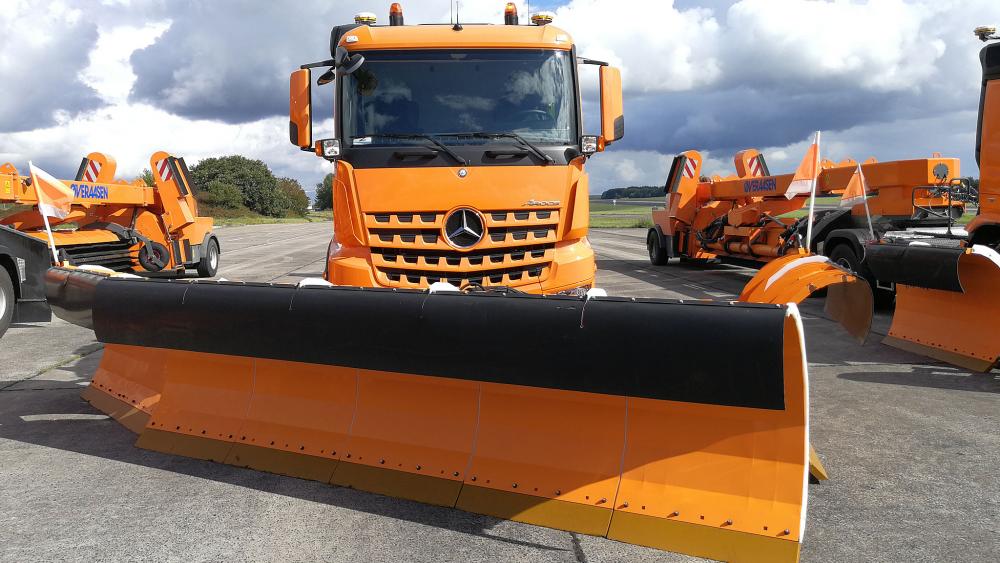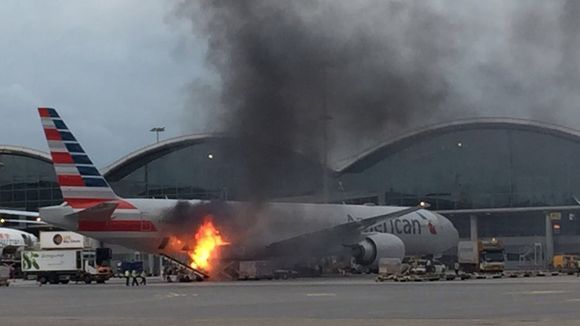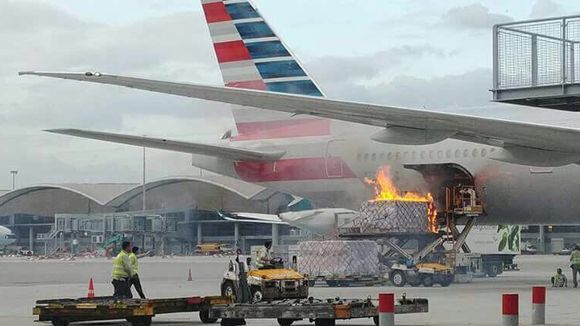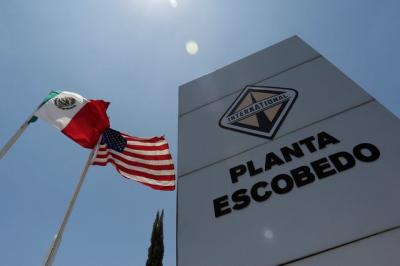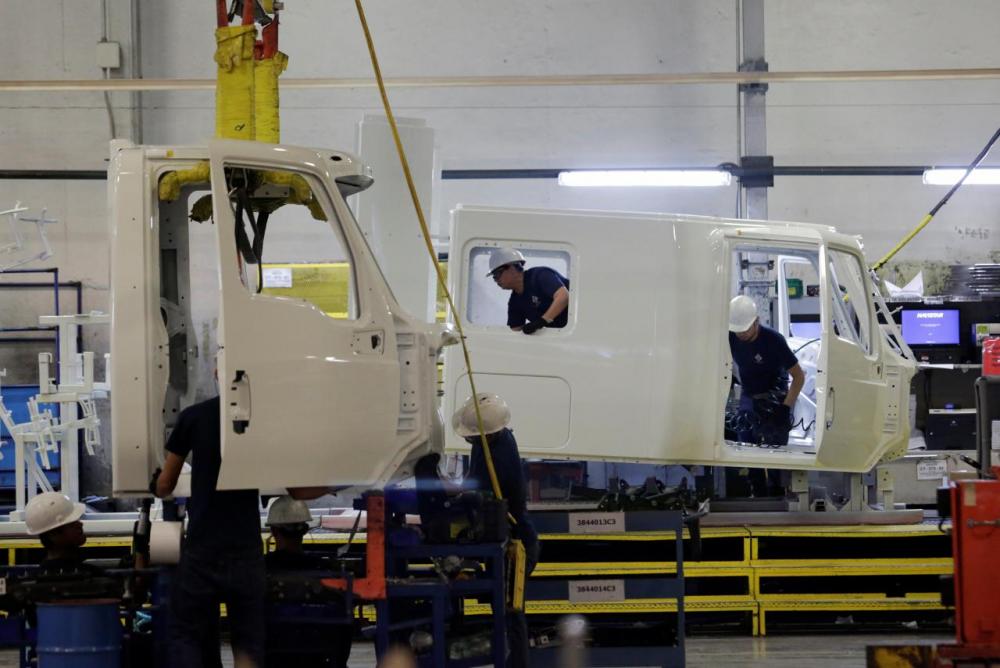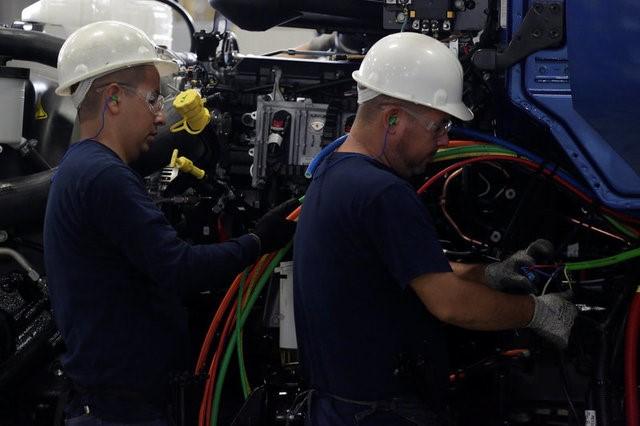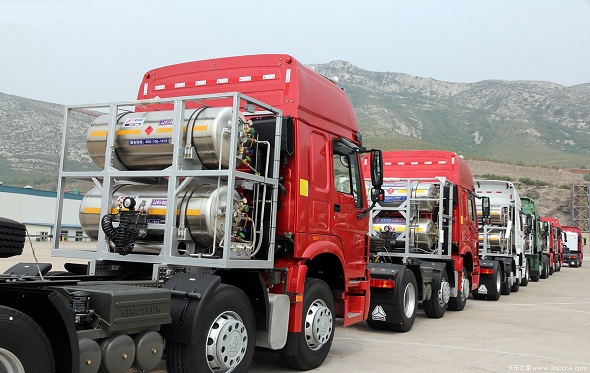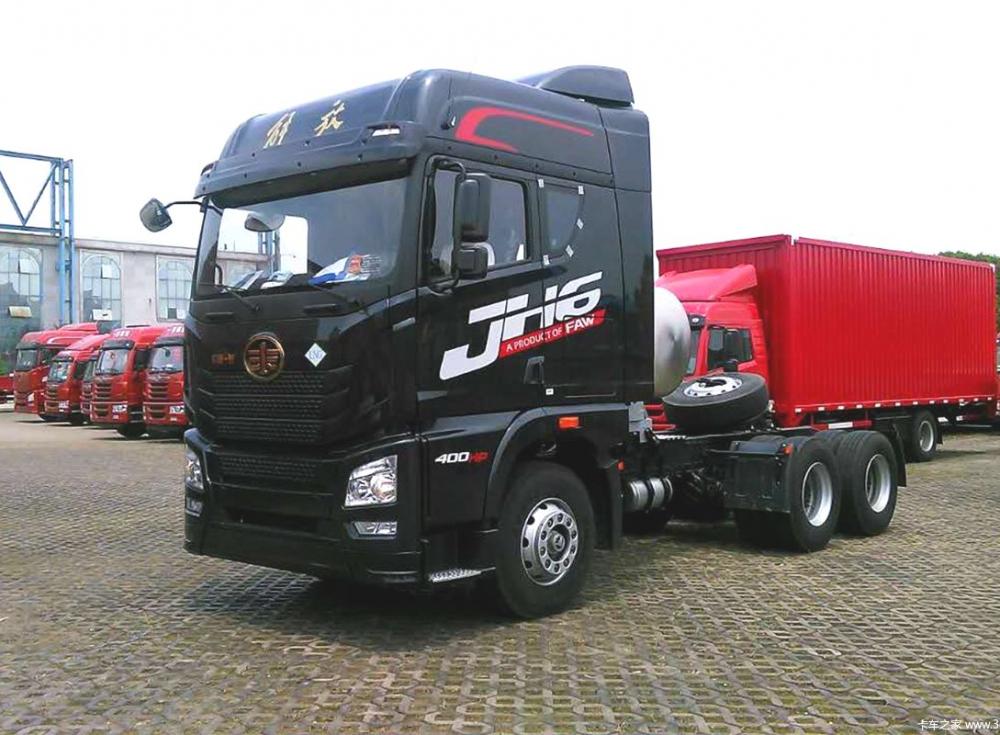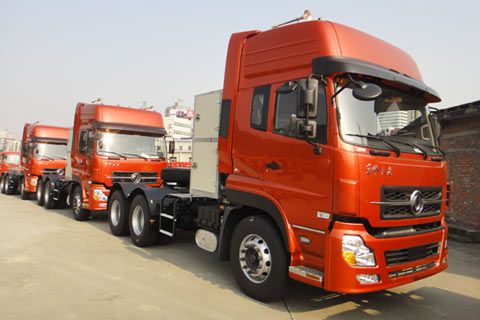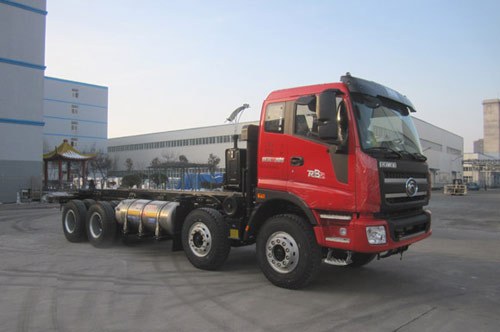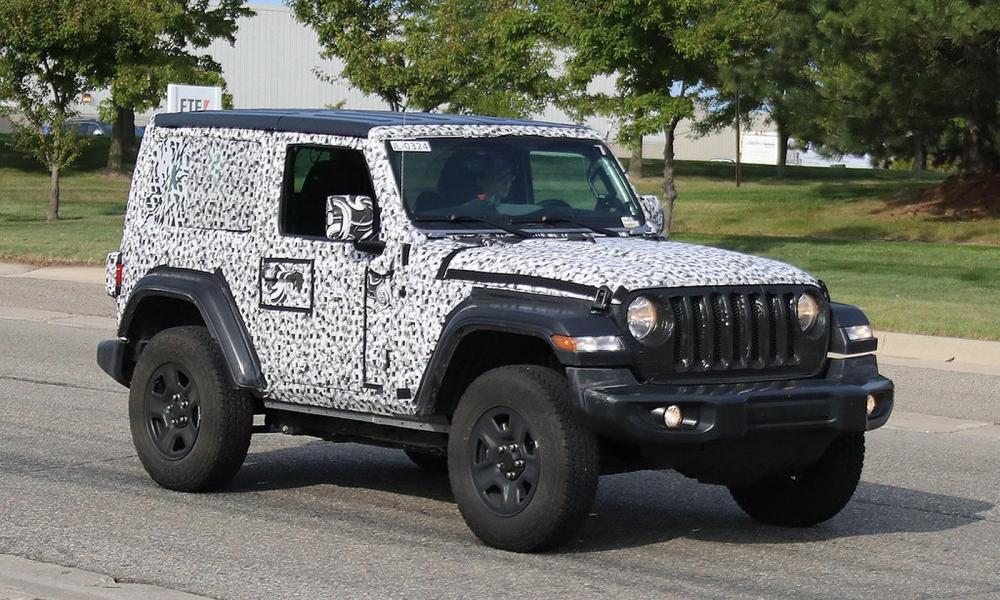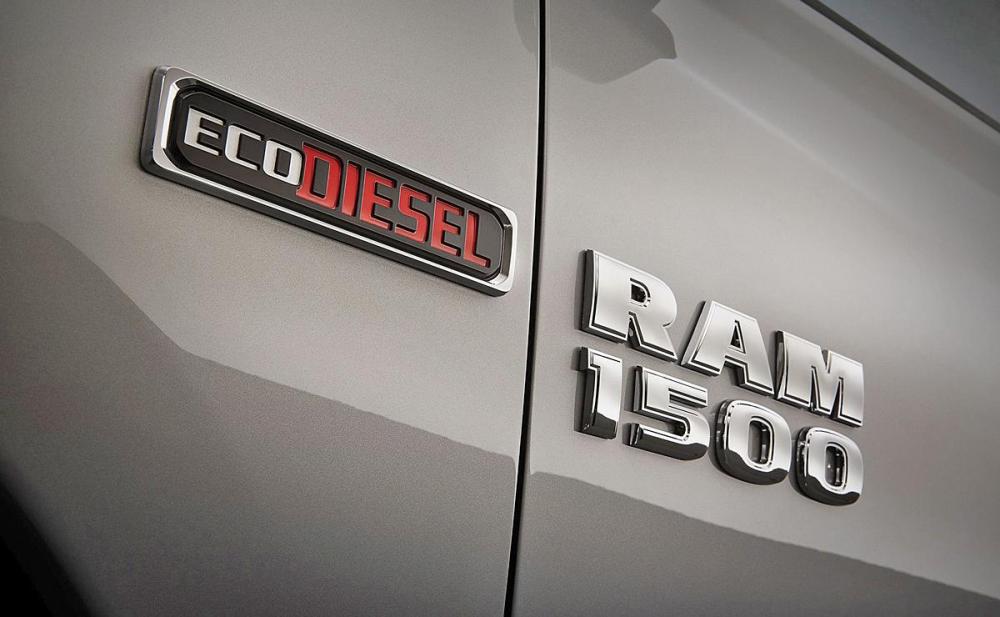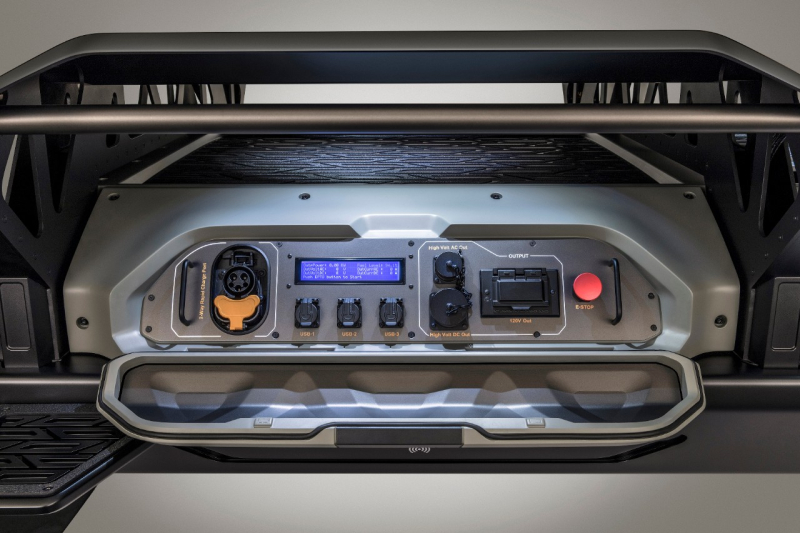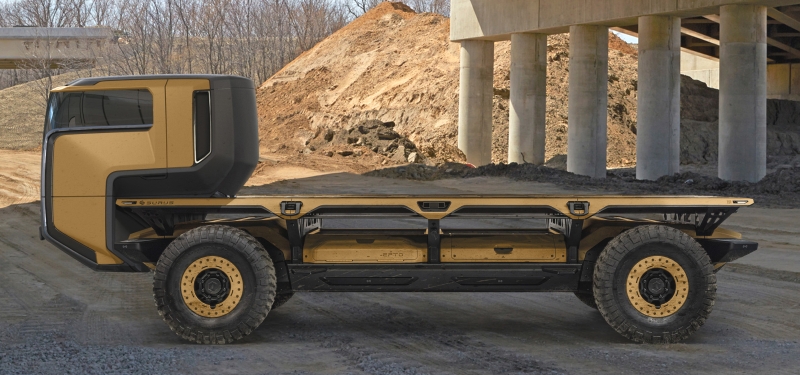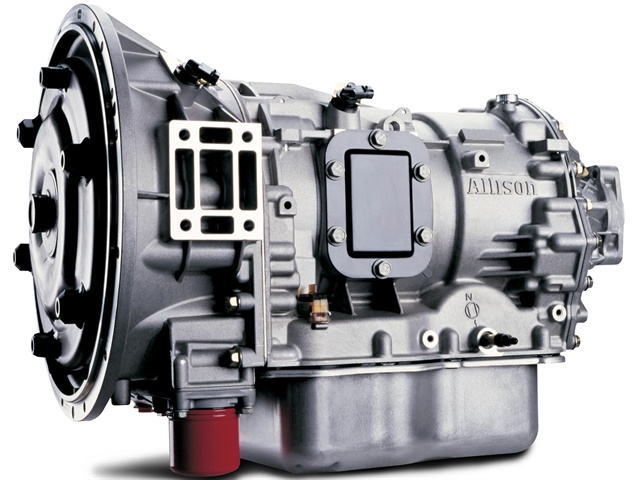
kscarbel2
Moderator-
Posts
17,893 -
Joined
-
Days Won
86
Content Type
Profiles
Forums
Gallery
Events
Blogs
BMT Wiki
Collections
Store
Everything posted by kscarbel2
-
Green Car Congress / October 9, 2017 At the APTA public transportation show in Atlanta, GILLIG LLC a leading manufacturer of heavy-duty transit buses, and Cummins Inc. announced a technical collaboration focused on integrating and optimizing new battery electric technology from Cummins that will soon power GILLIG electric transit buses. At APTA, Cummins is introducing new powertrain configurable for either a full battery electric vehicle (BEV) or a range extended electric vehicle (REEV) incorporating a compact engine-generator. (Earlier post.) Initial development work will focus on a new battery electric GILLIG bus with a 200-mile operating range on a single charge. The bus will feature a direct-drive traction motor with peak torque of 3500 N·m (2,582 lb-ft), and utilize energy recovered from a regenerative braking system. A package of e-accessories will be powered by the Cummins system. The initial bus deployment will use a plug-in charger. The Cummins electrified powertrain on show here at APTA represents a major leap forward for the industry, and we are delighted that GILLIG will have first access to this important zero-emissions technology. The partnership enables a close technical collaboration so we can accelerate system integration and performance optimization work to leap ahead of others in the industry. Beyond the technical development work, the partnership will also encompass the full range of 24/7 service support, diagnostics, over-the-air connectivity, flexible warranty plans and training programs ready for when these GILLIG electric buses enter service. —Amy Boerger, Cummins Vice President — Sales North America Cummins currently powers the GILLIG series of Low Floor, BRT, BRTPlus, Commuter and Trolley buses with a broad portfolio of diesel, near-zero natural gas and diesel-hybrid power systems. The addition of Cummins electrified power systems to the bus range will align with transit customers looking to introduce zero-emissions buses to their fleets while still maintaining commonality with their existing GILLIG vehicles and service support provision. .
-
BYD raises capacity, adds new electric models at California bus plant Automotive News / October 10, 2017 BYD Co. has hiked the annual production capacity at a California electric bus assembly plant to 1,500 units -- up from 300 previously -- to meet growing demand in North America. The latest expansion will allow the factory to build electric trucks and special purpose vehicles, as well as buses. The addition of a new wing has nearly quadrupled the plant’s floor space to 450,000 square feet. The factory now employs 800 workers, up from 300, with plans to hire 400 more. The Lancaster, Calif., plant, which opened in 2013, is BYD's first overseas EV assembly plant. It has delivered 137 electric buses in the United States and Canada. Deliveries this year total 75 buses, and customers have ordered 300 more. BYD assembles buses and other EVs in China, California, Scotland and Brazil, and is building plants in Hungary, France and Ecuador. BYD, based in the south China city of Shenzhen, is listed in Hong Kong and Shanghai. It is partly owned by U.S. billionaire Warren Buffett.
-
The Financial Times / October 9, 2017 Daimler Trucks is aiming to get ahead of rivals in the shift to mobility services with a simplified, self-driving fleet of lorries that can remove snow at airports and make it safe for aircraft to land. The 25-tonne, bright orange lorries are unique in the world of self-driving vehicles because they are automated rather than autonomous. This means they take a predefined route rather than making split-second decisions on direction through the use of sensors. “We don’t need artificial intelligence, we don’t need the latest technology,” said Philipp Dreyer, who heads the project. “It’s not so much autonomous in the sense of watching the surroundings and making decisions, it’s more a predefined lane that is basically stored, digitally, in the vehicle.” The technology is deliberately simpler than more sophisticated vehicles, such as the Google Waymo car with its built-in cameras, to keep costs low and make the project viable before others in 2019. The project underscores that big developments in driverless vehicles are likely to come from the transportation sector itself, rather than consumers who want the convenience of a car that navigates a city on its own. “The first movers won’t be the consumer,” said David Park, vice-president of marketing at Optimal Plus, a big data analytics company. “It’s the trucking industry, the taxi industry. They want the efficiencies and scale of continuous driving. These are industries where time, literally, is money.” In a demonstration of the technology at a private airport 90 minutes outside of Frankfurt, an operator sitting in the driver’s seat of the four-lorry convoy’s lead vehicle typed in a few commands. The lorry accelerated, turned on to the runway and began to travel at 30km an hour. Three identical, unoccupied lorries made the same moves at a safe distance behind the lead vehicle, then shifted into a staggered formation and dropped high-speed snow-clearing brushes on to the pavement in a simulation of clearing the snow away. Daimler can set the parameters within an inch of where the vehicles should drive. The project was commissioned by Frankfurt Airport, whose “winter services” of de-icing aircraft and clearing runways will cost €23m this year. The trouble is, the airport must have specialist drivers at the ready even when it does not snow. So it tasked Daimler with creating a driverless platoon that could carry out the mission, 24 hours a day. For Daimler, the challenge was an opportunity to move from selling a product to creating a solution tailor-made for a customer. The company said 40 airports of similar size around the world would be potential customers. .
-
A fluke, or an improvised explosive device (IED) that went off prematurely. ----------------------------------------------------------------- Raging inferno beside American Airlines plane spooks passengers RT / October 9, 2017 Dramatic footage of a raging inferno breaking out next to the terminal at Hong Kong’s Chek Lap Kok international airport as cargo was being loaded onto an American Airlines Boeing 777 aircraft has emerged. Passengers are seen looking on in horror as flames appear on one side of the plane. The fire broke out at approximately 5:30pm local time on Monday. The cargo loader itself reportedly caught fire, which in turn spread to the container it was placing on board the aircraft. The fire did not actually spread to the plane, however. When a loading vehicle was loading cargo onto the plane it caught on fire,” a police spokesperson said, as cited by the AFP. The loader operator sustained minor injuries according to an American Airlines spokesperson Martha Thomas, as cited by USA Today. Thomas said that despite the lack of damage to the aircraft itself, the flight was cancelled “out of an abundance of caution.” All affected passengers have already been booked on alternate flights. . .
-
Reuters / October 9, 2017 Less than half the trucks exported from Navistar’s mammoth Escobedo plant in Mexico are sold in North America but the factory’s success remains tightly tied to the uncertain future of the region’s NAFTA free trade deal. Navistar’s Mexican factory, now the U.S. company’s largest worldwide, exports to around 30 countries and sells less to the United States than competitors such as Daimler AG, one of the top three truck-makers in Mexico, which sends three-quarters of its Mexican-made commercial vehicles north. But Navistar’s reliance on tariff-free imported parts shows why even Mexico manufacturers that have diversified their customer base away from the United States still fear U.S. President Donald Trump’s threats to scrap NAFTA. “To lose this treaty would be to go backwards 40 years,” said Oscar Ruiz, operations director at the plant, fearing a return to an era when barriers made foreign investment and trade expensive between the two neighbors. Trade negotiators from the United States, Mexico and Canada will meet this week in Washington for a fourth round of talks on reworking NAFTA amid growing signs of an impasse between the Trump administration and the other two signatories of the pact. Mexican officials warn that Trump is leading the region towards a protectionist trade war with his “America First” policy, flirting with major curbs on commerce. Nowadays, over half the original parts for the vehicles made at Navistar’s 250 acre (100 hectare) site in the northern state of Nuevo Leon arrive duty-free from the United States and Canada in hundreds of trailers every day, Ruiz said. Higher tariffs on imports or reduced trade flows would raise the cost of production and of exporting to the United States. That would make trucks more expensive for all Navistar’s customers, experts consulted by Reuters said. Navistar, for example, uses Alabama-made Cummins engines in its International Prostar and LT heavy tractors. Without NAFTA, importing the engines would likely cost 10 percent more, based on World Trade Organization tariffs, according to Manuel Nieblas, a manufacturing consultant at Deloitte Mexico. With engines representing up to 45 percent of the $130,000 cost of a Prostar truck, that tariff alone could add around $5,800 to the final price. Prices would also rise for most of the up-to 12,000 parts used in a Navistar truck, both due to the tariffs and slower border-customs checks if trade were to be more regulated. A ‘LOGISTIC SPRINGBOARD’ Aside from higher prices for imported parts, ending NAFTA would likely impose a 4 percent tariff on top of the total value of the Class 8 truck 18-wheeler for export to the United States. Still, that might be slight enough for U.S. consumers to absorb, or for the company to shave off its margins. And Navistar’s strategy of using Mexico’s low costs and multiple free trade deals to export to markets from Saudi Arabia to Australia could soften the blow of any tougher export rules for the United States, Mexican Chief Executive Carlos Pardo said. “More than ever I believe Mexico is a logistic springboard, where on top of a qualified work force and reasonable production costs, logistically it has created the connections to supply any part of the world,” Pardo said in Navistar’s Mexico City headquarters. While 98 percent of trucks exported from Mexico go to the United States or Canada, U.S. truckmaker Kenworth, China’s Giant and Korean automaker Kia all have a similar strategy of building in Mexico to export to countries other than the United States. Scrapping NAFTA might not hurt exports to robust European economies, but those to Latin America, Navistar’s top market after North America, would become much more complicated, said Salvador Pasquel, an automotive expert at Baker McKenzie. Business with Colombia, which in 2011 was the biggest market in Latin America for U.S. truck companies after Mexico, helps illustrate what could happen if NAFTA collapses. Sales plummeted after vehicles got more expensive because of changes in Colombia’s trade policy, including a tax of 15 percent on the value of new imported heavy trucks. “We went from exporting $817 million in heavy tractors in 2011 to barely $1 million in 2015,” said Miguel Elizalde, president of Mexico’s truck and bus business chamber, Anpact. One fear for Mexico-based companies is that increased costs there would boost Latin American sales of trucks made in Brazil, whose vehicle industry belongs to the Mercosur free trade bloc. “If it’s harder for Mexico to place its products in Latin America, the big economy that could provide those cars and trucks would surely be Brazil,” said Baker McKenzie’s Pasquel. The worries over NAFTA coincide with a recovery in Navistar’s U.S. market. After a long stretch of depressed sales, orders for Class 8 trucks in the United States soared for the fourth consecutive month in September, according to preliminary data from industry forecaster FTR. (here) Analysts expect a strong year in 2018. Although Lisle, Illinois-based Navistar posted a second quarter loss, its share price has recovered lately as the company turns itself around after a disastrous bet on a costly and unsuccessful smog-reduction system. Last year, Volkswagen’s truck unit said it was buying a stake in Navistar as part of an alliance in which the two companies will share technology. In Mexico, growth of truck-making under NAFTA has been rapid. In 1993, a year before the deal took effect, Mexico exported 1,040 heavy vehicles. Last year, it sold 106,161 such vehicles abroad, according to Anpact figures. Navistar’s Escobedo plant was producing three vehicles a day when it opened in 1998. It now makes 160, with capacity for almost double that, factory manager Ruiz said. The company is under no illusion it could maintain those volumes without NAFTA, though the plant recently decided to hire 150 new workers because of recovering U.S. demand. “We could survive, yes, but the question is, at what level?” Ruiz said. .
-
Cummins Press Release / October 4, 2017 Cummins celebrates 50 years of innovation at the Cummins Technical Center (CTC) in Columbus, Indiana. You can learn more about the CTC's 50 years at http://social.cummins.com/cummins-technical-center-celebrates-50-years-innovation/ .
-
Sean Kilcarr, Fleet Owner / October 6, 2017 A supplier’s view of why trailers need more connectivity, security, and tracking capabilities. Rob Phillips, president and COO of Phillips Industries, will tell you that trailers can no longer be an afterthought in the trucking industry. With cargo thieves targeting loads with higher values, the need for more security is growing. With e-commerce helping to both increase freight demand and at the same time placing new business pressures on truckers large and small, trailer uptime is becoming more critical. There’s also a productivity issue to be addressed as well when it comes to trailers – especially in cases where a truckers mistakenly hooks up to the wrong trailer in a crowded freight yard and hauls it 400 miles down the road before realizing the error. Those, then, are just some of the many trailer-related issues Phillips expects new technology to help solve in the near future – technology that will on the one hand provider greater security for both the trailer and its cargo, while at the same time producing more detailed “real-time” data to make trailers more productive assets. “There’s a lot of complexity when it comes to geofencing strategies, for example” he told American Trucker. “Trailers are moved around [freight yards] and distribution centers a lot. You don’t want to force drivers to enter in security codes every time they shift a trailer from one dock to another.” There’s also the issue of “customization” to address as well, for some truckers want the pieces of critical tracking technology placed in the nose of their trailers for easy serving, while others want such systems “hidden” from the eyes of potential thieves and ne’er do wells. “You want a system that offers a ‘simple solution’ in terms of the hardware that’s used; a system that is robust; and one’s that not a killer to install, too,” Phillips said. That’s one reason his family’s company launched a new division earlier this year – Phillips Connect Technologies (PCT) – to tap into patent-pending “plug and play connectivity,” combined with an “open platform” design, in order to seamlessly get many sensor-driven components supplied by various component manufacturers to work together in a single system. “We’ve been working for several years to develop this; to figure out ways to help make the industry safer and more efficient,” he said, One facet of that effort is Connect:Security – a patented trailer lock-down system aims to stops theft by locking the air brakes on a trailer when power is disconnected from the tractor. In order to release the brakes and pull the trailer, a PIN code from dispatch has to be keyed in from a smart device to a control box designed by PCT. Other items in this package include remote trailer door lock/unlock as well as a theft-deterrent video surveillance system, Phillips noted. Right now the company is beta testing this system, with plans to commercially launch it in 2018. “We’re building prototypes and testing them because you can’t push technology like this too fast,” he stressed. “It needs to work, with a fair amount of redundancy built in, so it doesn’t ‘lock up’ the trailer at the wrong moment. It also must be easier to fix and be easy to use for tracking when triggered. But in the end it means more security against cargo theft.” Phillips also recently partnered with Velvac’s Road iQ subsidiary to collaborate on a new offering called TrailerLink – a connectivity solution designed to support trailer-to-tractor video and data communications. The system augments the traditional tractor-trailer 7-pin electrical connection with an additional 15-pin cable connection. When combined with Phillips’ trailer-mounted dual nosebox and additional tractor-mounted tail box, it offers a more secure real-time video and data connection between tractor and trailer, he noted. More importantly, it provides connectivity that is immune to the noise, interference, and latency concerns associated with other data transmission approaches, Phillips said. “Pairing trailer cameras via Wi-Fi to a driver’s smart-devices isn’t easy or reliable, and light-duty coiled cables struggle to do the trick,” he explained. “TrailerLink is designed specifically for sending high-speed and noise-free video data from the trailer to the driver.” Phillips also pointed out that the initial release of TrailerLink will support the connection of up to four exterior or interior trailer-mounted cameras to displays and recording devices in the tractor, with its “open architecture” designed to support current industry standard data and video signals as well as lay the groundwork for adapting to future communication protocols.
-
General Motors establishing new military defense division Automotive News / October 9, 2017 Automaker in talks about adopting platform for use by Army DETROIT — General Motors plans to establish a new defense industry unit as it seeks to grow its business with the U.S. military, Automotive News has learned. The company said last week it is holding talks with the U.S. Army about adopting the company's new hydrogen fuel cell platform for military use, and has other defense projects in the works. GM Defense LLC is expected to become part of the company's Global Product Development organization, marking a major return to defense work after selling a previous defense unit to General Dynamics Corp. for $1.1 billion in 2003. Anticipating needs The operations, according to officials, will be focused on "helping GM better anticipate and react to the diverse needs of global aerospace and defense customers." "This new business structure will enhance GM's productivity, agility and affordability in a very dynamic customer environment," said Charlie Freese, executive director of GM Global Fuel Cell Business, in an emailed statement to Automotive News. "Our goal is to make it simpler and more seamless to do business with General Motors." Freese will oversee GM Defense as part of Global Product Development, which is led by Mark Reuss, GM vice president of Global Product Development, Purchasing and Supply Chain. The company has not determined where the defense unit will be based, said GM spokeswoman Elizabeth Winter. GM currently provides powertrain components such as engines and transmissions to the military, but of late it has expanded its potential military offerings. The automaker has at least three hydrogen fuel cell products under evaluation by U.S. military divisions, including the new commercial platform with autonomous capabilities. GM said last week that it is in discussions with the Army Tank Automotive Research, Development and EngineeringCenter about the Silent Utility Rover Universal Superstructure (SURUS) platform. The company said SURUS could be "a next step of the broader collaboration to evaluate fuel cell technology for future military applications." Winter declined to disclose details of the discussions. "The platform is still in development," she wrote in an email. "We do not confirm timings or details of future product." In addition to the fuel cell-powered, four-wheel concept, the Army has been testing a fuel cell-powered Chevrolet Colorado known as the ZH2 on U.S. bases since April. The U.S. Navy last year also unveiled a GM fuel cell-powered unmanned undersea vehicle for testing. GM officials say SURUS, based on a heavy-duty truck frame, was designed as a "foundation" for a new generation of commercial vehicles that leverages a single propulsion system integrated into a common chassis. They say it was not specifically designed for military use. "This is our commercial fuel cell solution that we think will solve real-world, near-term problems," Freese told reporters last week during a preview of SURUS in Warren, Mich. The platform will be at the meeting of the Association of the U.S. Army this week in Washington, D.C. Outside of military use, GM is evaluating SURUS for applications such as freight; mobile and emergency backup power generation; light- and medium-duty trucks; and emergency rescue vehicles such as ambulances and others used in disaster-relief efforts. GM says SURUS leverages the company's newest Hydrotec fuel cell system, which is capable of more than 400 miles of range, as well as autonomous capability and truck chassis components. It's driven by two electric motors. Benefits include quiet and odor-free operation, off-road mobility, field configuration, instantaneous high torque, exportable power generation, water generation and fast refueling. Related reading - https://www.bigmacktrucks.com/topic/51304-gm-to-show-hydrogen-powered-truck-chassis-to-military-buyers/?tab=comments#comment-381863
-
Ford, in strategy shift, to develop EV vans for China Reuters | 2017/10/6 BEIJING - Ford Motor Co. likely will develop electric commercial vans for China as part of its bid to catch up with global rivals in China’s fast-moving market. Two high-ranking company insiders told Reuters that the new China strategy comes as CEO Jim Hackett rethinks the company’s global "One Ford" strategy. The shift in China would match Ford’s assumption that it can profitably develop electric and autonomous delivery vehicles, a segment where it is already strong in the United States and Europe. The “One Ford” strategy – which helped the automaker’s turnaround under former CEO Alan Mulally – doesn’t fit all regions, the two insiders said, particularly in China and India, two crucial markets where Ford’s sales have slowed. “That’s why nobody internally talks about 'One Ford' (in those markets) anymore,” said one of the insiders, who is familiar with Ford’s Chinese strategy. In a sign that Ford is turning away from a global push of its Ford and Lincoln brands, the U.S. automaker wants to position its truck-making Chinese partner Jiangling Motors Corp. in the market for electric commercial vans. Such a move is "potentially lucrative" as China’s big cities effectively ban gas and diesel trucks and vans, said Yale Zhang, head of Shanghai-based consultancy Automotive Foresight. “None of the foreign automakers has made any major investment or strategic move in this emerging electric commercial vehicle segment,” Zhang added. Sherif Marakby, Ford’s vice president of autonomous vehicles and electrification, told Reuters that he couldn’t comment on specific partnerships that haven’t been announced. “But we are absolutely open to (EV) partnerships in different markets, and we continue to talk to other companies and Tier One suppliers,” Marakby said. “Don’t be surprised to see more partnerships in electric vehicles in different markets.” China ventures In August, Ford said it was considering a joint venture with Anhui Zotye Automobile Co. to build electric vehicles in China under a new brand, tapping Zotye’s low-cost technology. One insider said Ford is seeking China’s regulatory approval for this. Ford has also brought in Jason Luo, a Chinese-born American, from U.S.-based airbag supplier Key Safety Systems to run its Chinese operations. One insider said Luo has been tasked to build closer ties with local partners Jiangling Motors and Changan Automobile Co. He also has been asked to work more effectively with regulators and respond more quickly to changing consumer tastes. “One big issue at Ford China is that our decision-making process is too slow,” one of the knowledgeable insiders said. “We try to manage everything, all aspects of the business under One Ford,” and that has hobbled the company’s ability to move quickly. Ford’s China sales are expected to decline 4.6 percent this year, according to LMC Automotive, a far cry from double-digit growth just five years ago. Slow lane Ford has no affordable electric plug-in cars for the Chinese market, even though Beijing announced new quotas last month for battery-electric cars and plug-in hybrids. Nor does Ford have a high-volume brand of affordable entry-level cars for China - such as the Baojun cars sold by General Motors and its partner, SAIC. Launched in 2010, Baojun sold more than 2 million vehicles last year. Ford was slow to expand Jiangling Motors – in which it owns a one-third stake – from the light commercial sector into entry-level passenger cars. That segment now has now become saturated with domestic Chinese models plus joint-venture brands like Baojun and Nissan Motor Co.’s Venucia. Ford’s missteps in China were caused by rigid adherence to the “One Ford” mantra and a lack of local knowledge, one insider said. Company executives sent into China often lacked the cultural ties to work with Chinese regulators, policymakers and partners. China’s market, consumer tastes and government policies shift rapidly, the source noted. “Ford is having difficulty keeping up with ‘China speed’. Everything here moves so fast.”
-
Reuters / October 8, 2017 YUTIAN, China (Reuters) - On a recent morning in Yutian, a dusty town bisected by the highway that connects Beijing to the sea, Su Meiquan strolled into a dealership packed with hulking trucks and prepared to drive off with a brand new rig. After years of driving a diesel truck for a trucking company, he had decided to buy his own vehicle – a bright red rig fueled with liquefied natural gas, capable of hauling as much as 40 tonnes of loads like steel or slabs of marble. Su hopes the LNG truck - less polluting and cheaper to operate than diesel ones - will be the cornerstone of his own business, plying the route to the western fringes of China. “Everybody says gas is cleaner with nearly no emissions,” he said after signing a stack of paperwork in the dealer’s office. In front of him, photos of proud drivers posing in front of their own new LNG trucks had been taped to the wall. Sales of large LNG trucks are expected to hit record levels in China this year as the government steps up an anti-pollution campaign that includes curbs on diesel heavy trucks. LNG trucks account for about four percent of the more than six million heavy vehicles able to haul 40 to 49 metric tons (88,185lb to 108,027lb) of goods that are currently on China’s roads. The vast majority of the 43 billion tons of freight transported across China last year was by highway. But demand for LNG trucks is soaring as companies and manufacturers shift to vehicles that run on the gas that Beijing sees as a key part of its war against smog. Sales of LNG heavy trucks surged 540 percent to nearly 39,000 in the first seven months of the year, according to Cassie Liu, a truck analyst with the IHS Markit consultancy. That was partly fueled by a ban this year on the use of diesel trucks to transport coal at northern ports in provinces like Hebei and Shandong, and in the city of Tianjin. “We are seeing a blowout in LNG trucks this year, thanks to the government’s policy push,” said Mu Lei, marketing manager for China National Heavy Duty Truck Group (CNHTC), known as Sinotruk, one of the leading heavy truckmakers. The shift to gas trucks is helping fuel demand for LNG in China, as are other government measures aimed at clearing the air, especially in the north, which is shrouded in a hazardous coal-fueled smog for much of the winter. One major project is piping gas to 1.4 million households across the north for heating this winter, shifting away from coal. China, already the world’s No.3 LNG consumer, has seen imports jump 45 percent so far this year. Chinese companies like Jereh Group and ENN Energy Holding, which build LNG filling stations, and Zhangjiagang CIMC Sanctum Cryogenic Equipment Co., Ltd, which specialises in LNG tanks, are expected to benefit from the gas boom, analysts said. OVERLOADING, PORTS Government restrictions on cargo overloading last year has also driven truck sales as operators rushed to buy bigger trucks. Next month, Beijing will also impose restrictions on thousands of northern factories using diesel trucks, forcing many to use more rail and others to consider gas-powered trucks. Sales of new heavy trucks, including diesel and LNG vehicles, jumped 75 percent in the January-August period to 768,214. Last week, Sinotruk received new orders for 1,371 heavy trucks, 900 of which run on LNG, at an event bringing together coal transport companies from seven northern Chinese cities. In the first half of this year, Sinotruk sold 5,200 LNG trucks, up 650 percent year on year. “Gas trucks are both more environmentally friendly and more economical,” said Lai Wei, general manager of Tianjin Shengteng Transport Company, a privately-run trucking company. Lai is tripling his LNG fleet to more than 100 by the end of this year, adding 65 new Shaanxi brand heavy trucks. He is also cutting back his diesel fleet to 30 from 50 previously because of the new emissions rules in Tianjin that come into effect this month. Only vehicles meeting “National Five” emissions standards, equivalent to Euro 5 standards for trucks and buses in Europe, will be allowed to operate at the port. Lai said he was also concerned that there might be further restrictions on diesel trucks in a few years. CLEANER, CHEAPER China, the world’s top energy consumer, wants gas, which emits half the carbon dioxide as that of burning coal, to supply 15 percent of energy demand by 2030, up from 6 percent currently. That effort stalled in 2014 as an oil price slump lifted demand for diesel. But as oil prices have risen in the past 20 months, rebounding to above $50, LNG sales, especially from Australia and the United States, have soared. Diesel costs between 10-30 percent more than gas on average currently at Chinese gas stations, according to truck companies. For Su, the new truck owner in Yutian, about 140 kilometers to the east of Beijing, price is a major reason for making the switch from diesel. He plans to hire two drivers to shuttle the 3,500 kilometers between Yutian and Urumqi, in the northwestern region of Xinjiang, to carry steel products west and coal or other goods on the way back. “It really suits our journeys as the longer the trip, the more you save on fuel on an LNG truck,” he said. He is paying 390,000 yuan (US$58,710) for a new truck from Sinotruk, about 60,000 yuan (US$9,032) more than a diesel truck would have cost. “On a return trip, we can save 3,000 yuan (US$452) in fuel,” he added. “That means we’ll be able to recoup within a year the extra cost on the vehicle.” .
-
The Secret Room Where the Ford Model T Was Developed
kscarbel2 replied to kscarbel2's topic in Odds and Ends
I aim to please. -
The Secret Room Where the Ford Model T Was Developed
kscarbel2 replied to kscarbel2's topic in Odds and Ends
I thought so too Bob. I like the idea of one team assembling the entire car. -
2018 Jeep Wrangler to offer optional 368-hp 4-cylinder engine
kscarbel2 replied to kscarbel2's topic in Odds and Ends
AEV's JK Wrangler is available with either the 5.7L or 6.4L HEMI. https://www.aev-conversions.com/vehicles/jk-wrangler https://secure.aev-conversions.com/shop/products/powertrain/jk-hemi-kit https://www.caranddriver.com/reviews/jeep-wrangler-aev-hemi-conversion-first-drive-reviews . -
how to make a single axle rd dump truck 4x4
kscarbel2 replied to gio400's topic in Driveline and Suspension
This is the US market system from Poclain Hydraulics - http://eztracawd.com/ Related reading - https://www.bigmacktrucks.com/topic/39998-volvo-unveils-automatic-all-wheel-drive-truck-tech/?hl=optitrack#entry289755 -
Automotive News / October 6, 2017 The redesigned 2018 Jeep Wrangler will feature an optional turbocharged 2.0-liter inline-four engine that produces 368 hp, according to documents Fiat Chrysler filed with the National Highway Traffic Safety Administration (NHTSA). Thetruthaboutcars.com broke the story, which was picked up by posters on Wrangler-centric website jlwranglerforums.com. The Wrangler forum site posted the document, a vehicle identification number decoder. While a new inline-four variant is listed, the VIN decoder does not identify a diesel-powered Wrangler, which could come later or may have been postponed because of FCA's ongoing issues with regulators over its diesel emissions. The next-generation Wrangler, dubbed JL, will begin production within the next several weeks but isn't expected to show up at dealerships until after the new year. The document indicates that the redesigned Wrangler will come standard with its current 285-hp 3.6-liter V-6. Both engines will be mated to a new-to-the-Wrangler eight-speed automatic transmission to improve fuel economy. .
-
2017 diesel Rams are finally on dealer lots Automotive News / October 7, 2017 DETROIT — It's taken a couple months, but EcoDiesel-powered 2017 Ram 1500s have begun to show up on dealership lots for the first time since the federal government accused Fiat Chrysler of not disclosing software that changed the way the vehicle's emissions system operates. But though FCA received official clearance in late July to begin selling 2017 Ram 1500s and Jeep Grand Cherokees powered by its 3.0-liter EcoDiesel engine, the variants may not be around for long. The EPA has yet to certify sales for the coming 2018 model year, a spokeswoman for the agency said. Some dealers began receiving their first EcoDiesel Ram 1500s of the year in late September, according to dealer websites. Others have yet to receive diesel vehicles they ordered. FCA began producing EcoDiesel Rams in early July in anticipation of receiving clearance from the EPA to sell the vehicles, but it didn't begin shipping them to dealers for more than two months. FCA suspended production of EcoDiesel-powered Ram 1500 and Grand Cherokees in late 2016 because they hadn't received certification. In January, the EPA hit FCA with a notice of violation over eight pieces of emissions control software the agency alleges illegally altered vehicle emissions under certain circumstances. In May, the Department of Justice's Environmental and Natural Resources Division filed a civil suit against FCA over undeclared diesel emissions software. FCA says it is continuing to cooperate with the EPA and the California Air Resources Board "to clarify issues related to the Company's emissions control technology" in hopes of settling its dispute. The automaker said in May that it "has developed updated emissions software calibrations that it believes address the concerns of EPA and CARB." FCA said that if it receives permission from the EPA and CARB, it "intends to install the same modified emissions software in 2014-2016 MY Jeep Grand Cherokee and Ram 1500 diesel vehicles." .
-
Car & Driver / October 4, 2017 Big inventions are often created in small spaces. A classic example of that can now be seen in Detroit: specifically, on the third floor of the brick building at 461 Piquette, which housed the assembly plant of the Ford Motor Company from 1904 to 1910. More significant, it was the birthplace of the Ford Model T, a car that put automobile ownership within reach of people of average means and as a result accelerated America’s transition from a rural to an urban society. In the northeast corner of the third floor, an L-shaped room measuring 870 square feet has been set aside and refurbished to replicate its state when it was the exact space where the Model T evolved from concept to production readiness. Now known as the “secret experimental room,” the space was originally partitioned off from the rest of the factory floor in January 1907, with a padlock on the door when the room wasn’t in use. Only a trusted few of Ford’s workmen had access to the space. 1907 R&D Set up by foundry boss Charlie Sorensen, the room was established for what Henry Ford described as a “completely new job.” At that point, Ford’s Model N, together with its sportier R and S variants, was the top-selling car in America, and the experimental-room team embarked on the job with the anticipation that they’d be crafting an evolution of the Model N. But Henry Ford’s concept was more revolutionary. As his autobiography, My Life and Work, records, Ford intended the T to be “a motorcar for the great multitude,” a car big enough for family use that was light, durable, and affordable. Based on physical evidence in the building, surveys by industrial archaeologist Richard Anderson, and 1950s interviews with workers employed at the plant at the time the Model T was birthed, a team of experts and volunteers brought the experimental room back to life. This included appointing it with the equipment the T team employed in 1907 and 1908: a drafting table, a chalkboard, a camera to record design ideas, a workbench, tool boxes, workers’ lunch pails, and a 250-volt DC motor turning an overhead line shaft that powered belt-driven machine tools—a lathe, a drill press, and a milling machine. The space is illuminated by reproductions of the original GE arc lamps, fabricated by Detroit’s Kirlin Lighting, using a 3D printer and an authentic original lamp purchased from a Canadian collector. Piquette insiders note that the purchase of that vintage lamp cost more than the price of the original Model T. An old rocking chair duplicates the rocker Henry Ford occupied while directing operations, and a Model N chassis represents the starting point of the T project. 1908 Prototypes The ideas and brainstorming burgeoned in early 1907, and by the spring of 1908 the first of several running prototypes rolled out of the secret experimental room and onto public roads, whereupon the T was not so secret anymore. Production began on September 27, 1908, with the formal public debut occurring on October 1. The T was an instant success—not so much because of its price, though, at least at first. With a base price of $850 for the original five-passenger touring car, it was less expensive than many contemporary automobiles but some $250 more than the Model N. Irresistibly low prices came later, with the economies of scale that set in after Ford established the moving assembly line in 1913. What set the T apart was innovation, simplicity, and exceptional ruggedness. For example, Ford specified vanadium steel for a number of stressed components such as the crankshaft, axles, and wheel spindles, reducing weight and enhancing durability. Developed in Europe, vanadium alloyed steel had been tested in earlier Ford models and was used more extensively in the Model T, contributing to low curb weight (about 1200 pounds) and a chassis capable of surviving the then primitive U.S. road system. Other innovations included a one-piece engine block (most contemporary engine cylinders were cast in pairs) and a removable cylinder head that made maintenance and repair infinitely easier. The magneto, which sent juice to the spark plugs, was integrated with the flywheel, the flexible frame helped the T survive on deeply rutted dirt highways, and the planetary transmission made the car easy to drive. Today, the walls of the experimental room are cut away on two sides to give visitors a close look at its historic appointments. The room itself is augmented by backlit panels that trace the story of the T’s gestation from concept to running prototype, as well as a video kiosk with five short descriptions of the key elements that made the Model T stand out from the crowd. Piquette Museum In addition to serving as the home to the re-created experimental room, the Piquette plant is itself a museum, its top two floors home to a wide variety of cars from the T and pre-T era. Piquette was Ford’s first purpose-built factory. Before the T, it was the source of models B, C, F, K, N, R, and S. As with the previous models, T production at Piquette was based around single stations—where one team assembled the entire car. Ford and his staff kept tweaking the process to speed production, but station-style assembly, which was then common to all vehicle production everywhere, continued up to and beyond the time that Ford left Piquette for a vast new factory in nearby Highland Park in January 1910. Still, during those 15 months some 12,000 Model Ts rolled out of Piquette. Ford sold the Piquette plant to Studebaker, which produced vehicles there until 1933. Subsequent tenants were Minnesota Mining and Manufacturing (3M) and the Cadillac Overall Company, among others. In 2000—with the impending prospect of demolition facing the facility—the property was acquired by the Model T Automotive Heritage Complex, a private group dedicated to preserving the Piquette factory and commemorating its singular historic significance. In its Model T heyday, Ford was just one of 22 different carmakers in the area, which was then called Milwaukee Junction for its proximity to rail transportation. Recognized as a National Historic Landmark in 2006, the Ford Piquette Avenue Plant is open to visitors 10 a.m. to 4 p.m. Wednesday through Sunday from April through November. From December through March, the plant is open 10 a.m. to 4 p.m. Friday through Sunday. Photo gallery - https://www.caranddriver.com/photo-gallery/this-is-the-secret-room-where-the-ford-model-t-was-developed-gallery#1
-
Allison plans new nine-speed automatic transmission
kscarbel2 replied to kscarbel2's topic in Trucking News
Allison Transmission introduces new 9AT for release in 2020 Green Car Congress / October 6, 2017 Allison Transmission recently introduced its first nine-speed model at the North American Commercial Vehicle Show in Atlanta. The innovative, fully automatic transmission, for medium- and heavy-duty vehicles, will be available globally and is targeted for release in 2020. With its deep first gear ratio and industry-leading ratio coverage, the Allison nine-speed transmission provides significant fuel savings as the efficient gear train allows the torque converter to lock up early in first gear. Additionally, the nine-speed includes an integral engine stop-start system that provides immediate transmission engagement and vehicle hold while the engine is restarted. Providing value for a variety of applications, the nine-speed model is suited for distribution trucks, rental and lease trucks, and school buses. With this new transmission, Allison continues to demonstrate its commitment to help achieve standards regarding fuel efficiency and greenhouse gas (GHG) emissions. This release coincides with the timing of the Environmental Protection Agency (EPA) Phase 2 GHG and Fuel Efficiency Standards. When combined with FuelSense, our software and electronic controls packages, and our other fuel-saving technologies, the nine-speed will set a new benchmark in fuel efficiency and reduced emissions, achieving Greenhouse Gas Emissions Model (GEM) benefits. —Randy Kirk, senior vice president of product engineering and product teams with Allison Transmission Prototype evaluations for OEMs in North America, Europe and Asia begin this year. The Allison nine-speed model leverages the proven durability of the Allison 2000 Series six-speed commercial transmissions, which have accumulated more than 100 billion miles globally. It has been designed to utilize the same OEM interfaces as its six-speed predecessor, providing ease of integration into vehicles currently released with the Allison 2000 Series. Drivers will experience even better comfort due to smaller steps, allowing for a smoother start. They’ll also enjoy improved acceleration, which can lead to more productivity. -
Allison Expands Fuel-Efficient Medium-Duty Transmission Tech
kscarbel2 replied to kscarbel2's topic in Trucking News
Allison Transmission extends xFE fuel-saving to Series 1000, 2000 Green Car Congress / October 6, 2017 Allison Transmission recently announced availability of its latest fuel economy technology for its 1000 Series and 2000 Series at the North American Commercial Vehicle Show in Atlanta. Referred to as xFE, designating extra fuel economy, the fully automatic bus and truck transmissions have demonstrated improvements up to 7% when compared to baseline models. Other than our electric hybrid products, xFE models represent the very best fuel economy technology we offer. Our goal with this expansion of the xFE portfolio is to also now achieve the best fuel economy from an automatic transmission in smaller, medium-duty buses and trucks. The new design works to achieve enhanced fuel economy in start-stop dense, low average speed duty cycles. Transit and city buses are the ideal candidates for this technology and that’s why we’ve remained focused on those applications. —John Coll, senior vice president of global marketing, sales and service for Allison Transmission The 1000 Series and 2000 Series xFE transmissions have the same space claim and ratings as current models, but incorporate a redesigned torque converter damper coupled with the FuelSense 2.0 Max package. The damper enables first range lock up, delivering significantly more lock up operation and operating at lower engine speeds in higher ranges to further improve fuel economy. All xFE transmissions are compatible with alternative fuel engines. First announced in 2015, xFE transmissions were exclusively available in the 3000 Series for bus applications. The new models represent the first expansion of the xFE portfolio and come standard with FuelSense 2.0. Announced in March, FuelSense 2.0 with DynActive Shifting delivers additional fuel savings beyond original FuelSense software. Through a set of proprietary software enhancements, the new FuelSense 2.0 uses DynActive Shifting to provide an infinitely variable combination of shift points and uses a learning algorithm to continuously find the ideal balance of fuel economy and performance. Available in three packages, FuelSense 2.0 allows fleets to optimize fuel economy and performance to their specific needs. -
Green Car Congress / October 6, 2017 Cummins will reveal electrified power technology for transit bus applications at the APTA public transportation show opening in Atlanta on 9 October. Cummins will display a new powertrain, configurable for either a full battery electric vehicle (BEV) or a range extended electric vehicle (REEV) incorporating a compact engine-generator. Enhanced energy storage for both the BEV and REEV systems is achieved using Cummins’ high-density battery enclosures, which are compact and modular allowing for both on-roof and chassis integration. Cummins’ unique design fits into existing bus designs. Cummins’ proprietary control technology enables the zero-emissions bus range to be extended by optimally managing subsystems, allowing the charge of the battery to be extended. Operational flexibility is also improved with fast recharge capability using a plug-in connection, as well as options for en-route charging when a pantograph or charge plate infrastructure is available. The introduction of our new BEV and REEV systems will complement Cummins’ clean-diesel, near-zero natural gas and diesel-hybrid products to offer the broadest, most energy-diverse power portfolio in the bus industry. We are able to meet the needs of every transit route, every duty cycle and every emissions standard in the most cost-effective manner. —Julie Furber, Executive Director, Electrification Business, Cummins The standard-size Cummins battery enclosure provides a 70-kWh storage capability with up to 8 enclosure units (560 kWh) suited for installation within the BEV bus. This enables a zero-emissions range of up to 224 miles (360 km) on a single charge, with an energy consumption of 25 mpg diesel-equivalent, which provides significant cost reductions. Cummins REEV system has a battery pack of three enclosures (210 kWh) which can provide a zero-emissions range of up to 84 miles (135 km)—a significant advantage over current hybrid bus capability. When the battery pack depletes to a low state-of-charge, the REEV system brings online a 150-kW (201-hp) engine-generator to recharge the batteries and continue operations with ultra-low emissions capability. Compared to the standard diesel-powered bus, the REEV 4.5-liter engine is downsized by about 50% in terms of displacement and can achieve up to 10 mpg, significantly lowering the carbon footprint. A power assist function is available from the battery pack whenever the system needs additional energy. The REEV system’s ability to switch between shorter-range battery-only mode and extended-range generator mode allows transit authorities to geofence specific downtown areas by utilizing Cummins over-the-air connected technology. The REEV system also enables buses to travel significant distances beyond the city charging infrastructure. A key focus in the design of both our BEV and REEV systems ensures the electrified architecture is modular and adaptable to enable an easier technology transition for bus manufacturers. This allows transit authorities to continue using the same preferred bus models and retain fleet commonality. The new systems will be expertly serviced and supported by Cummins’ distribution network the same way we currently provide 24/7 support for our diesel-, hybrid- and natural-gas-powered fleets. This is an important factor for transit authorities, because as they adopt new technologies they can count on Cummins to help with a transition to BEV and REEV technology. —Brian Wilson, Cummins General Manager — Global Bus Business The BEV and REEV systems incorporate the same traction motor and power electronics to deliver a continuous torque output of 1850 N·m (1,365lb-ft), eliminating the need for gear shifting and reducing powertrain noise. When the vehicle requires additional tractive power during rapid acceleration or while climbing gradients, the system can deliver an instant peak torque boost of up to 3400 N·m (2,508 lb-ft) for a short period. Both systems provide a continuous electrical output of 225 kW (302 horspower), increasing to a peak output of 350 kW (469 horsepower) when it senses the need for a power boost. The high-voltage system operates at a nominal 660V when battery state-of-charge is around 50%. Battery energy storage levels are boosted on-route by accepting “free” energy recovered through regenerative braking. On a frequent stop/start bus duty cycle, this could contribute the equivalent of 20% to the total state-of-charge. Electrical energy is also exportable from the Cummins system to all electric-powered accessories featured on the bus, such as e-power steering, e-HVAC, e-air compressors and e-cooling fans, adding up to a typical 25-kW (33-horsepower) load at any one time. The electrical supply from the Cummins system can be both low-voltage DC and high-voltage AC, helping to simplify the installation and lower the cost of the e-accessories package. The same electronic control module used on the popular L9, L9N and B6.7 bus engines is adapted for use as the BEV and REEV system controller, offering familiar diagnostics and the connectivity that bus operators experience today. Further information will be coming next week.
-
GM to Show Hydrogen-Powered Truck Chassis to Military Buyers
kscarbel2 replied to kscarbel2's topic in Trucking News
GM provides a few more details on SURUS fuel cell four-wheel steer concept truck Green Car Congress / October 7, 2017 Earlier this month, GM outlined its electric path to zero emissions, and introduced SURUS—the Silent Utility Rover Universal Superstructure (SURUS)—a fuel-cell-powered, four-wheel steer concept vehicle on a heavy-duty truck frame that’s driven by two electric motors. (Earlier post.) Now, GM has provided a few additional insights into the construction of and role for SURUS. SURUS leverages GM’s newest Hydrotec fuel cell system, autonomous capability and truck chassis components to deliver high-performance, zero-emission propulsion to minimize logistical burdens and reduce human exposure to harm. Benefits include quiet and odor-free operation, off-road mobility, field configuration, instantaneous high torque, exportable power generation, water generation and quick refueling times. Fuel cell technology represents a key piece of General Motors’ zero emission strategy. It offers a solution that can scale to larger vehicles with large payload requirements and operate over longer distances. SURUS was designed to form a foundation for a family of commercial vehicle solutions that leverages a single propulsion system integrated into a common chassis. The SURUS platform is equally well-suited for adaptation to military environments where users can take advantage of flexible energy resources, field configurability and improved logistical characteristics. GM is evaluating multiple applications for SURUS, such as: Utility trucks Mobile and emergency backup power generation Flexible cargo delivery systems Commercial freight Light- and medium-duty trucks, improving upon the Chevrolet Colorado ZH2 that has been evaluated by the US military under guidance of the US Army Tank Automotive Research, Development and Engineering Center (TARDEC) and is undergoing testing on bases (earlier post) (The ZH2 is the first fuel cell vehicle to wear the GM Hydrotec badge, a familial tie to the Ecotec gasoline engines.) Future military-specific configurations SURUS will deliver highly mobile autonomous capability and agility in unpredictable terrain. Operating multiple vehicles in a leader-follower configuration could reduce manpower needed. For future potential military uses, the system’s inherent low heat signature and quiet operation offer benefits in environments to reduce detection and risks. TARDEC has been in discussions with GM evaluating the commercial SURUS concept as a next step of the broader collaboration to evaluate fuel cell technology for future military applications. SURUS redefines fuel cell electric technology for both highway and off-road environments. General Motors is committed to bringing new high-performance, zero-emission systems to solve complex challenges for a variety of customers. —Charlie Freese, executive director of GM Global Fuel Cell Business The SURUS platform leverages GM’s vast experience in fuel cell technology, high-voltage batteries and electric drive systems, autonomous driving and vehicle manufacturing. The platform features: Two advanced electric drive units Four-wheel steering Lithium-ion battery system Gen 2 fuel cell system Hydrogen storage system capable of more than 400 miles of range Advanced propulsion power electronics GM truck chassis components An advanced, industry-leading suspension The SURUS commercial platform draws on GM’s more than 50 years of research and development of fuel cell technology. The scalable and adaptable technology enables land, sea and air applications across commercial and military environments. Since April 2017, the Army has been testing the commercial Chevrolet Colorado ZH2 on its US bases to determine the viability of hydrogen-powered vehicles in military mission tactical environments. The vehicle has been operating in off-road conditions to evaluate its power generation, reduced odor, acoustic and thermal signatures, high wheel torque, extended operating range and the potential to use the byproduct water. Military testing has shown the ZH2 reduced acoustic non-detection distance by 90% compared to current military vehicle in operation. This means the ZH2 can get 10 times closer before being detected. Leaders also observed the potential advantages for stationary power generation over diesel generators, including a significant reduction in idle noise and fuel use. Testing will continue through spring 2018. Partnerships remain an important part of GM’s electrification strategy. Last year, the US Navy unveiled a GM fuel cell-powered Unmanned Undersea Vehicle (UUV) for testing purposes that leverages GM fuel cell technology common with the Colorado ZH2. General Motors aims to solve some of the toughest transportation challenges created by natural disasters, complex logistics environments and global conflicts. The company will display its Silent Utility Rover Universal Superstructure (SURUS), a flexible fuel cell electric platform with autonomous capabilities, at the fall meeting of the Association of the United States Army (AUSA) from 9-11 October 2017. The commercially designed platform could be adapted for military use. . -
Fleet Owner / October 6, 2017 Peterbilt announced the availability of the new 12-speed Eaton Endurant transmission in Models 579 and 567. Available with the Cummins X15 Efficiency series engine in ratings up to 510-hp and 1,850 lb.-ft. of torque, the Endurant will service vehicles in regional and line-haul applications up to 110,000 lbs. GVW. The Endurant transmission comes standard with the PACCAR column mounted shifter. A cooler-free precision lubrication system, encapsulated sensors and wiring, and standard 8-bolt PTO opening location, and a 750,000-mile lube change interval are among some of the key features. “The Endurant transmission was optimized for the Cummins X15 engine and gives our customers another powertrain option,” said Scott Newhouse, Peterbilt chief engineer. “Endurant has a wide range of benefits including its light weight design and longer service intervals. Its integration with the column mounted shifter will make it a top choice for both fleet and owner operator customers.” Peterbilt provides aftermarket support programs through its 350-plus North American dealer locations that complement its full lineup of on-highway, vocational and medium duty products, including alternative fuel vehicles. Peterbilt offers SmartLINQ connected truck technologies, expedited Rapid Check diagnostic services, the Red Oval certified used truck program, automated parts inventory replenishment and 24/7 customer assistance through 1-800-4-Peterbilt.
-
Heavy Duty Trucking (HDT) / October 6, 2017 Allison Transmission has begun offering its xFE fuel-saving technology on two more of its medium-duty transmissions, including the 1000 Series and 2000 Series, the company has announced. The xFE technology, which stands for extra fuel economy, can improve fuel efficiency by 7% when compared to baseline models. The technology was previously available on select 3000 Series models. The 1000 Series and 2000 Series transmissions are usually paired with smaller medium-duty trucks and buses. They offer the same ratings as current models and incorporate a redesigned torque converter damper coupled with the FuelSense 2.0 Max package. The damper enables first range lock up and delivers significantly more lock up operation, according to the company. They operate at lower engine speeds in higher ranges to further improve fuel economy. The xFE transmissions are compatible with alternative fuel engines. Allison debuted its xFE transmissions in 2015 for 3000 Series buses. FuelSense 2.0 with DynActive shifting debuted in March. Allison employs a series of software enhancements to provide a variable combination of shift points and learning algorithm that searches for the ideal balance of fuel economy and performance. Allison transmissions also use Continuous Power Technology to smoothly multiple engine torque and deliver more power to the wheels. .
BigMackTrucks.com
BigMackTrucks.com is a support forum for antique, classic and modern Mack Trucks! The forum is owned and maintained by Watt's Truck Center, Inc. an independent, full service Mack dealer. The forums are not affiliated with Mack Trucks, Inc.
Our Vendors and Advertisers
Thank you for your support!


